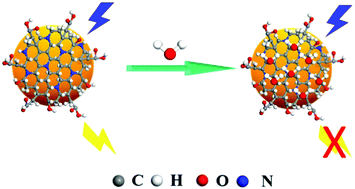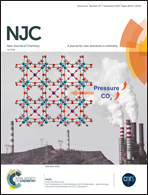A novel fluorescent sensor for water in organic solvents based on dynamic quenching of carbon quantum dots†
Abstract
In this study, a simple and straightforward method has been developed to prepare carbon quantum dots (CQDs) with ultrahigh absolute fluorescence quantum yields (96.9%). The fluorescence peak of CQDs remains the same (565 nm) due to their homogeneous surface structure, when the excitation wavelength was changed from 300 nm to 500 nm. It was found that the as-prepared CQDs exhibit excellent fluorescent properties in organic solvents, but could be quenched by water. As a result, the as-prepared CQDs are promising fluorescent probes for the detection of water in organic solvents without any modification. To our knowledge, this is the first time that CQDs have been adopted as water-sensitive fluorescent probes in organic solvents (ethanol, tetrahydrofuran, and 1,4-dioxane) with a limit of detection as low as 0.01% (V/V). What is more, the dynamic quenching mechanism of the CQDs–water system was clarified by UV-vis absorption spectrometry and time-resolved fluorescence spectrometry.



 Please wait while we load your content...
Please wait while we load your content...